The Effects of Surfactants and Essential Oils on Microwave−Assisted Hydrothermal Synthesis of Iron Oxides
Abstract
1. Introduction
2. Materials and Methods
2.1. Materials
2.2. Synthesis
2.3. Characterization Techniques
3. Results
3.1. FTIR Analysis
3.2. PXRD Characterization
3.3. SEM Analysis
4. Discussion
5. Conclusions
Supplementary Materials
Author Contributions
Funding
Institutional Review Board Statement
Informed Consent Statement
Data Availability Statement
Conflicts of Interest
References
- Cornell, R.M.; Schwertmann, U. The Iron Oxides: Structure, Properties, Reactions, Occurrence, and Uses, 2nd ed.; John Wiley & Sons: Weinheim, Germany; New York, NY, USA, 2003; pp. 1–664. [Google Scholar]
- Yang, S.; Xu, Y.; Sun, Y.; Zhang, G.; Gao, D. Size-controlled synthesis, magnetic property, and photocatalytic property of uniform α-Fe2O3 nanoparticles via a facile additive-free hydrothermal route. CrystEngComm 2012, 14, 7915. [Google Scholar] [CrossRef]
- Huang, J.R.; Yang, M.; Gu, C.P.; Zhai, M.H.; Sun, Y.F.; Liu, J.H. Hematite solid and hollow spindles: Selective synthesis and application in gas sensor and photocatalysis. Mater. Res. Bull. 2011, 46, 1211–1218. [Google Scholar] [CrossRef]
- Mohapatra, S.K.; John, S.E.; Banerjee, S.; Misra, M. Water Photooxidation by Smooth and Ultrathin α-Fe2O3 Nanotube Arrays. Chem. Mater. 2009, 21, 3048–3055. [Google Scholar] [CrossRef]
- Wu, C.; Yin, P.; Zhu, X.; OuYang, C.; Xie, Y. Synthesis of Hematite (alpha-Fe2O3) Nanorods: Diameter-Size and Shape Effects on Their Applications in Magnetism, Lithium Ion Battery, and Gas Sensors. J. Phys. Chem. B 2006, 110, 17806–17812. [Google Scholar] [CrossRef]
- Jaiswal, A.; Banerjee, S.; Mani, R.; Chattopadhyaya, M.C. Synthesis, characterization and application of goethite mineral as an adsorbent. J. Environ. Chem. Eng. 2013, 1, 281–289. [Google Scholar] [CrossRef]
- Mohapatra, M.; Anand, S. Synthesis and applications of nano-structured iron oxides or hidroxides—A review. Int. J. Eng. Sci. Technol. 2010, 2, 127–146. [Google Scholar] [CrossRef]
- Lu, A.-H.; Salabas, E.L.; Schueth, F. Magnetic nanoparticles: Synthesis, protection, functionalization, and application. Angew. Chem. Int. Ed. 2007, 46, 1222–1244. [Google Scholar] [CrossRef]
- Wu, W.; He, Q.; Jiang, C. Magnetic iron oxide nanoparticles: Synthesis and surface functionalization strategies. Nanoscale Res. Lett. 2008, 3, 397–415. [Google Scholar] [CrossRef]
- Teja, A.S.; Koh, P.-Y. Synthesis, properties, and applications of magnetic iron oxide nanoparticles. Prog. Cryst. Growth Charact. Mater. 2009, 55, 22–45. [Google Scholar] [CrossRef]
- Schwertmann, U.; Cornell, R.M. Iron Oxides in the Laboratory: Preparation and Characterization; Wiley VCH: Weinheim, Germany, 2000; 204p. [Google Scholar]
- Žic, M.; Ristić, M.; Musić, S. Fe57 Mössbauer, FT-IR and FE SEM investigation of the formation of hematite and goethite at high pH values. J. Mol. Struct. 2007, 834, 141–149. [Google Scholar] [CrossRef]
- Gotić, M.; Popović, S.; Ljubešić, N.; Musić, S. Structural Properties of Precipitates Formed by Hydrolysis of Fe3+ Ions in Aqueous Solutions Containing NO3− and Cl− Ions. J. Mater. Sci. 1994, 29, 2474–2480. [Google Scholar] [CrossRef]
- Musić, S.; Vertes, A.; Simmons, G.W.; Czakonagy, I.; Leidheiser, H. Mössbauer spectroscopic study of the formation of Fe(III) oxyhydroxides and oxides by hydrolysis of aqueous Fe(III) salt-solutions. J. Colloid. Interface Sci. 1982, 85, 256–266. [Google Scholar] [CrossRef]
- Šarić, A.; Musić, S.; Nomura, K.; Popović, S. Microstructural properties of Fe-oxide powders obtained by precipitation from FeCl3 solutions. Mater. Sci. Eng. B 1998, 56, 43–52. [Google Scholar] [CrossRef]
- Musić, S.; Santana, G.P.; Smit, G.; Garg, V.K. Fe57 Mössbauer, FT-IR and TEM investigations of Fe-oxide powders obtained from concentrated FeCl3 solutions. J. Alloys Compd. 1998, 278, 291–301. [Google Scholar] [CrossRef]
- Musić, S.; Maljković, M.; Popović, S. Chemical and microstructural properties of iron oxide powders obtained from FeCl3 solutions with decomposing urea. ACH Models Chem. 1999, 136, 299–316. [Google Scholar]
- Musić, S.; Krehula, S.; Popović, S.; Skoko, Z. Some factors influencing forced hydrolysis of FeCl3 solutions. Mater. Lett. 2003, 57, 1096–1102. [Google Scholar] [CrossRef]
- Musić, S.; Krehula, S.; Popović, S. Effect of HCl additions on forced hydrolysis of FeCl3 solutions. Mater. Lett. 2004, 58, 2640–2645. [Google Scholar] [CrossRef]
- Krehula, S.; Music, S. Influence of ruthenium ions on the precipitation of α-FeOOH, α-Fe2O3 and Fe3O4 in highly alkaline media. J. Alloys Compd. 2006, 416, 284–290. [Google Scholar] [CrossRef]
- Ristić, M.; Musić, S.; Godec, M. Properties of γ-FeOOH, α-FeOOH and α-Fe2O3 particles precipitated by hydrolysis of Fe3+ ions in perchlorate containing aqueous solutions. J. Alloys Compd. 2006, 417, 292–299. [Google Scholar] [CrossRef]
- Gotić, M.; Musić, S. Mössbauer, FT-IR and FE SEM investigation of iron oxides precipitated from FeSO4 solutions. J. Mol. Struct. 2007, 834, 445–453. [Google Scholar] [CrossRef]
- Krehula, S.; Musić, S. Influence of aging in an alkaline medium on the microstructural properties of α-FeOOH. J. Cryst. Growth 2008, 310, 513–520. [Google Scholar] [CrossRef]
- Žic, M.; Ristić, M.; Musić, S. Microstructural changes in particles detected during the transformation from β-FeOOH to α-Fe2O3 in dense aqueous suspensions. J. Alloys Compd. 2008, 464, 81–88. [Google Scholar] [CrossRef]
- Gotić, M.; Musić, S.; Popović, S.; Sekovanić, L. Investigation of factors influencing the precipitation of iron oxides from Fe(II) containing solutions. Croat. Chem. Acta 2008, 81, 569–578. [Google Scholar]
- Žic, M.; Ristić, M.; Musić, S. Precipitation of α-Fe2O3 from dense β-FeOOH suspensions with added ammonium amidosulfonate. J. Mol. Struct. 2009, 924, 235–242. [Google Scholar] [CrossRef]
- Žic, M.; Ristić, M.; Musić, S. The effect of temperature on the crystallization of α-Fe2O3 particles from dense β-FeOOH suspensions. Mater. Chem. Phys. 2010, 120, 160–166. [Google Scholar] [CrossRef]
- Opačak, I.; Ristić, M.; Musić, S. Preparation and characterization of hollow alpha-Fe2O3 irregular microspheres. Mater. Lett. 2010, 64, 2555–2558. [Google Scholar] [CrossRef]
- Žic, M.; Ristić, M.; Musić, S. Monitoring the hydrothermal precipitation of α-Fe2O3 from concentrated Fe(NO3)3 solutions partially neutralized with NaOH. J. Mol. Struct. 2011, 993, 115–119. [Google Scholar] [CrossRef]
- Ristic, M.; Opacak, I.; Music, S. The synthesis and microstructure of goethite particles precipitated in highly alkaline media. J. Alloy Compd. 2013, 559, 49–56. [Google Scholar] [CrossRef]
- Ristić, M.; Fujii, T.; Hashimoto, H.; Opačak, I.; Musić, S. A novel route in the synthesis of magnetite nanoparticles. Mater. Lett. 2013, 100, 93–97. [Google Scholar] [CrossRef]
- Ristić, M.; Štajdohar, J.; Mitar, I.; Musić, S. Monitoring of the Forced Hydrolysis of FeCl3 Solutions in the Presence of Sodium Dodecyl Sulphate. Croat. Chem. Acta 2018, 91, 403–410. [Google Scholar] [CrossRef]
- Ristić, M.; Mitar, I.; Musić, S. Forced hydrolysis of FeCl3 solutions in the presence of sodium dextran sulphate. Colloid Polym. Sci. 2019, 297, 177–182. [Google Scholar] [CrossRef]
- Gupta, A.K.; Gupta, M. Synthesis and surface engineering of iron oxide nanoparticles for biomedical applications. Biomaterials 2005, 26, 3995–4021. [Google Scholar] [CrossRef] [PubMed]
- Wu, W.; Jiang, C.Z.; Roy, V.A.L. Designed synthesis and surface engineering strategies of magnetic iron oxide nanoparticles for biomedical applications. Nanoscale 2016, 8, 19421–19474. [Google Scholar] [CrossRef]
- Faraji, M.; Yamini, Y.; Rezaee, M. Magnetic nanoparticles: Synthesis, stabilization, functionalization, characterization, and applications. J. Iran. Chem. Soc. 2010, 7, 1–37. [Google Scholar] [CrossRef]
- Krehula, S.; Popović, S.; Musić, S. Synthesis of acicular α-FeOOH particles at a very high pH. Mater. Lett. 2002, 54, 108–113. [Google Scholar] [CrossRef]
- Matijevic, E.; Scheiner, P. Ferric Hydrous Oxide sols: III. Preparation of Uniform Particles by Hydrolysis of Fe(III)-Chloride, Fe(III)-Nitrate, and Fe(III)-Perchlorate Solutions. J. Colloid Interface Sci. 1978, 63, 509–524. [Google Scholar] [CrossRef]
- Hamada, S.; Matijevic, E. Formation of monodispersed colloidal cubic hematite particles in ethanol + water solutions. J. Chem. Soc. Faraday Trans. 1982, 78, 2147–2156. [Google Scholar] [CrossRef]
- Tavakoli, A.; Sohrabi, M.; Kargari, A. A review of methods for synthesis of nanostructured metals with emphasis on iron compounds. Chem. Pap. 2007, 61, 151–170. [Google Scholar] [CrossRef]
- Movlaee, K.; Ganjali, M.R.; Norouzi, P.; Neri, G. Iron-Based Nanomaterials/Graphene Composites for Advanced Electrochemical Sensors. Nanomaterials 2017, 7, 406. [Google Scholar] [CrossRef]
- Parsons, J.; Luna, C.; Botez, C.; Elizalde, J.; Gardea-Torresdey, J. Microwave assisted synthesis of iron(III) oxyhydroxides/oxides characterized using transmission electron microscopy, X-ray diffraction, and X-ray absorption spectroscopy. J. Phys. Chem. Solids 2009, 70, 555–560. [Google Scholar] [CrossRef]
- Yin, S.; Luo, Z.; Xia, J.; Li, H. Microwave-assisted synthesis of Fe3O4 nanorods and nanowires in an ionic liquid. J. Phys. Chem. Solids 2010, 71, 1785–1788. [Google Scholar] [CrossRef]
- Hu, X.L.; Yu, J.C.; Gong, J.M. Fast production of self-assembled hierarchical alpha-Fe2O3 nanoarchitectures. J. Phys. Chem. C 2007, 111, 11180–11185. [Google Scholar] [CrossRef]
- Mahmoud, W.E.; Al-Hazmi, F.; Al-Noaiser, F.; Al-Ghamdi, A.A.; Bronstein, L.M. A facile method to syntheses monodisperse gamma-Fe2O3 nanocubes with high magnetic anisotropy density. Superlattices Microstruct. 2014, 68, 1–5. [Google Scholar] [CrossRef]
- Deshmukh, R.G.; Badadhe, S.S.; Mulla, I.S. Microwave-assisted synthesis and humidity sensing of nanostructured alpha-Fe2O3. Mater. Res. Bull. 2009, 44, 1179–1182. [Google Scholar] [CrossRef]
- Katsuki, H.; Komarneni, S. Microwave-Hydrothermal Synthesis of Monodispersed Nanophase α-Fe2O3. J. Am. Ceram. Soc. 2001, 84, 2313–2317. [Google Scholar] [CrossRef]
- Yang, G.; Park, S.J. Conventional and Microwave Hydrothermal Synthesis and Application of Functional Materials: A Review. Materials 2019, 12, 1177. [Google Scholar] [CrossRef]
- Hasany, S.F.; Ahmed, I.; Rajan, J.; Rehman, A. Systematic review of the preparation techniques of iron oxide magnetic nanoparticles. Nanosci. Nanotechnol. 2013, 2, 148–158. [Google Scholar] [CrossRef]
- Wang, D.B.; Song, C.X.; Zhao, Y.H.; Yang, M.L. Synthesis and Characterization of Monodisperse Iron Oxides Microspheres. J. Phys. Chem. C 2008, 112, 12710–12715. [Google Scholar] [CrossRef]
- Wang, L.L.; Gao, L. Morphology-Controlled Synthesis and Magnetic Property of Pseudocubic Iron Oxide Nanoparticles. J. Phys. Chem. C 2009, 113, 15914–15920. [Google Scholar] [CrossRef]
- Mosivand, S.; Monzon, L.; Kazeminezhad, I.; Coey, J. Influence of growth conditions on magnetite nanoparticles electro crystallized in the presence of organic molecules. Int. J. Mol. Sci. 2013, 14, 10383–10396. [Google Scholar] [CrossRef]
- Bronstein, L.M.; Huang, X.; Retrum, J.; Schmucker, A.; Pink, M.; Stein, B.D.; Dragnea, B. Influence of Iron Oleate Complex Structure on Iron Oxide Nanoparticle Formation. Chem. Mater. 2007, 19, 3624–3632. [Google Scholar] [CrossRef]
- Jia, B.P.; Gao, L. Growth of Well-Defined Cubic Hematite Single Crystals: Oriented Aggregation and Ostwald Ripening. Cryst. Growth Des. 2008, 8, 1372–1376. [Google Scholar] [CrossRef]
- Yang, D.P.; Gao, F.; Cui, D.X.; Yang, M. Microwave Rapid Synthesis of Nanoporous Fe3O4 Magnetic Microspheres. Curr. Nanosci. 2009, 5, 485–488. [Google Scholar] [CrossRef]
- Shi, W.; Song, S.; Zhang, H. Hydrothermal synthetic strategies of inorganic semiconducting nanostructures. Chem. Soc. Rev. 2013, 42, 5714–5743. [Google Scholar] [CrossRef]
- Wang, W.W.; Zhu, Y.J.; Ruan, M.L. Microwave-assisted synthesis and magnetic property of magnetite and hematite nanoparticles. J. Nanopart. Res. 2007, 9, 419–426. [Google Scholar] [CrossRef]
- Savic, A.B.; Cokesa, D.; Lazarevic, S.; Jokic, B.; Janackovic, D.; Petrovic, R.; Zivkovic, L.S. Tailoring of magnetite powder properties for enhanced phosphate removal: Effect of PEG addition in the synthesis process. Powder Technol. 2016, 301, 511–519. [Google Scholar] [CrossRef]
- Mukhopadhyay, A.; Joshi, N.; Chattopadhyay, K.; De, G. A Facile Synthesis of PEG-Coated Magnetite (Fe3O4) Nanoparticles and Their Prevention of the Reduction of Cytochrome C. ACS Appl. Mater. Interfaces 2012, 4, 142–149. [Google Scholar] [CrossRef]
- Mahajan, R.; Suriyanarayanan, S.; Nicholls, I.A. Improved Solvothermal Synthesis of gamma-Fe2O3 Magnetic Nanoparticles for SiO2 Coating. Nanomaterials 2021, 11, 1889. [Google Scholar] [CrossRef]
- Muhammad Irshad, M.A.S.; Saqib, A.; Amjad, H. Biological importance of essential oils. In Essential Oils—Oils of Nature; IntechOpen: London, UK, 2019. [Google Scholar]
- Mihai, A.D.; Chircov, C.; Grumezescu, A.M.; Holban, A.M. Magnetite Nanoparticles and Essential Oils Systems for Advanced Antibacterial Therapies. Int. J. Mol. Sci. 2020, 21, 7355. [Google Scholar] [CrossRef]
- Pathania, D.; Sharma, M.; Sonu; Kumar, S.; Thakur, P.; Torino, E.; Janas, D.; Thakur, S. Essential oil derived biosynthesis of metallic nano-particles: Implementations above essence. Sustain. Mater. Technol. 2021, 30, e00352. [Google Scholar] [CrossRef]
- Sana, S.S.; Li, H.; Zhang, Z.; Sharma, M.; Usmani, Z.; Hou, T.; Netala, V.R.; Wang, X.; Gupta, V.K. Recent advances in essential oils-based metal nanoparticles: A review on recent developments and biopharmaceutical applications. J. Mol. Liq. 2021, 333, 115951. [Google Scholar] [CrossRef]
- Muniyappan, N.; Nagarajan, N.S. Green synthesis of gold nanoparticles using Curcuma pseudomontana essential oil, its biological activity and cytotoxicity against human ductal breast carcinoma cells T47D. J. Environ. Chem. Eng. 2014, 2, 2037–2044. [Google Scholar] [CrossRef]
- Dzimitrowicz, A.; Berent, S.; Motyka, A.; Jamroz, P.; Kurcbach, K.; Sledz, W.; Pohl, P. Comparison of the characteristics of gold nanoparticles synthesized using aqueous plant extracts and natural plant essential oils of Eucalyptus globulus and Rosmarinus officinalis. Arab J. Chem. 2019, 12, 4795–4805. [Google Scholar] [CrossRef]
- Manju, S.; Malaikozhundan, B.; Vijayakumar, S.; Shanthi, S.; Jaishabanu, A.; Ekambaram, P.; Vaseeharan, B. Antibacterial, antibiofilm and cytotoxic effects of Nigella sativa essential oil coated gold nanoparticles. Microb. Pathog. 2016, 91, 129–135. [Google Scholar] [CrossRef] [PubMed]
- Thanighaiarassu, R.R.; Sivamai, P.; Devika, R.; Nambikkairaj, B. Green Synthesis of Gold Nanoparticles Characterization by using Plant Essential Oil Menthapiperita and their Antifungal Activity against Human Pathogenic Fungi. J. Nanomed. Nanotechnol. 2014, 5, 1. [Google Scholar] [CrossRef]
- De Melo, A.P.Z.; de Oliveira Brisola Maciel, M.V.; Sganzerla, W.G.; da Rosa Almeida, A.; de Armas, R.D.; Machado, M.H.; da Rosa, C.G.; Nunes, M.R.; Bertoldi, F.C.; Barreto, P.L.M. Antibacterial activity, morphology, and physicochemical stability of biosynthesized silver nanoparticles using thyme (Thymus vulgaris) essential oil. Mater. Res. Express 2020, 7, 015087. [Google Scholar] [CrossRef]
- Nancy, B.A.; Elumalai, K. Synthesis of Silver Nanoparticles Using Pelargonium Graveolens Essential Oil and Anti-Fungal Activity. Int. J. Pharm. Biol. Sci. 2019, 9, 176–185. [Google Scholar] [CrossRef]
- Maciel, M.V.d.O.B.; Almeida, A.d.R.; Machado, M.H.; Melo, A.P.Z.d.; Rosa, C.G.d.; Freitas, D.Z.d.; Noronha, C.M.; Teixeira, G.L.; Armas, R.D.d.; Barreto, P.L.M. Syzygium aromaticum L. (Clove) Essential Oil as a Reducing Agent for the Green Synthesis of Silver Nanoparticles. Open J. Appl. Sci. 2019, 9, 45–54. [Google Scholar] [CrossRef]
- Vilas, V.; Philip, D.; Mathew, J. Catalytically and biologically active silver nanoparticles synthesized using essential oil. Spectrochim. Acta Part A 2014, 132, 743–750. [Google Scholar] [CrossRef]
- Vilas, V.; Philip, D.; Mathew, J. Biosynthesis of Au and Au/Ag alloy nanoparticles using Coleus aromaticus essential oil and evaluation of their catalytic, antibacterial and antiradical activities. J. Mol. Liq. 2016, 221, 179–189. [Google Scholar] [CrossRef]
- Sheny, D.S.; Mathew, J.; Philip, D. Synthesis characterization and catalytic action of hexagonal gold nanoparticles using essential oils extracted from Anacardium occidentale. Spectrochim. Acta Part A 2012, 97, 306–310. [Google Scholar] [CrossRef] [PubMed]
- Ahmadi, S.; Fazilati, M.; Nazem, H.; Mousavi, S.M. Green Synthesis of Magnetic Nanoparticles Using Satureja hortensis Essential Oil toward Superior Antibacterial/Fungal and Anticancer Performance. BioMed Res. Int. 2021, 2021, 8822645. [Google Scholar] [CrossRef] [PubMed]
- Chifiriuc, C.; Grumezescu, V.; Grumezescu, A.M.; Saviuc, C.; Lazar, V.; Andronescu, E. Hybrid magnetite nanoparticles/Rosmarinus officinalis essential oil nanobiosystem with antibiofilm activity. Nanoscale Res. Lett. 2012, 7, 209. [Google Scholar] [CrossRef] [PubMed]
- OriginPro, Version 2020b; OriginLab Corporation: Northampton, MA, USA, 2020.
- Rietveld, H.M. A Profile Refinement Method for Nuclear and Magnetic Structures. J. Appl. Crystallogr. 1969, 2, 65–71. [Google Scholar] [CrossRef]
- Hill, R.J.; Howard, C.J. Quantitative phase analysis from neutron powder diffraction data using the Rietveld method. J. Appl. Crystallogr. 1987, 20, 467–474. [Google Scholar] [CrossRef]
- HighScore Plus Program, Version 4.1; PANalytical: Almelo, The Netherlands, 2014.
- Unlu, C.G.; Kaynar, M.B.; Simsek, T.; Tekgul, A.; Kalkan, B.; Ozcan, S. Structure and magnetic properties of (La1−xFex)FeO3 (x = 0, 0.25, 0.50) perovskite. J. Alloys Compd. 2019, 784, 1198–1204. [Google Scholar] [CrossRef]
- Zepeda-Alarcon, E.; Nakotte, H.; Gualtieri, A.F.; King, G.; Page, K.; Vogel, S.C.; Wang, H.-W.; Wenk, H.-R. Magnetic and nuclear structure of goethite (α-FeOOH): A neutron diffraction study. J. Appl. Crystallogr. 2014, 47, 1983–1991. [Google Scholar] [CrossRef]
- Cambier, P. Infrared Study of Goethites of Varying Crystallinity and Particle-Size: 1. Interpretation of OH and Lattice Vibration Frequencies. Clay Miner. 1986, 21, 191–200. [Google Scholar] [CrossRef]
- Thomas Arrigo, L.K.; Byrne, J.M.; Kappler, A.; Kretzschmar, R. Impact of Organic Matter on Iron(II)-Catalyzed Mineral Transformations in Ferrihydrite–Organic Matter Coprecipitates. Environ. Sci. Technol. 2018, 52, 12316–12326. [Google Scholar] [CrossRef]
- Bowles, J.F.W. Hydroxides. In Encyclopedia of Geology, 2nd ed.; Alderton, D., Elias, S.A., Eds.; Academic Press: Oxford, UK, 2021; pp. 442–451. [Google Scholar]
- Thomas Arrigo, L.K.; Mikutta, C.; Byrne, J.; Kappler, A.; Kretzschmar, R. Iron(II)-Catalyzed Iron Atom Exchange and Mineralogical Changes in Iron-rich Organic Freshwater Flocs: An Iron Isotope Tracer Study. Environ. Sci. Technol. 2017, 51, 6897–6907. [Google Scholar] [CrossRef]
- Zielińska-Błajet, M.; Feder-Kubis, J. Monoterpenes and Their Derivatives—Recent Development in Biological and Medical Applications. Int. J. Mol. Sci. 2020, 21, 7078. [Google Scholar] [CrossRef] [PubMed]
- Ovais, M.; Khalil, A.T.; Islam, N.U.; Ahmad, I.; Ayaz, M.; Saravanan, M.; Shinwari, Z.K.; Mukherjee, S. Role of plant phytochemicals and microbial enzymes in biosynthesis of metallic nanoparticles. Appl. Microbiol. Biotechnol. 2018, 102, 6799–6814. [Google Scholar] [CrossRef] [PubMed]
- Ludwiczuk, A.; Skalicka-Woźniak, K.; Georgiev, M.I. Chapter 11—Terpenoids. In Pharmacognosy; Badal, S., Delgoda, R., Eds.; Academic Press: Boston, MA, USA, 2017; pp. 233–266. [Google Scholar]
- Venkata, A.L.K.; Sivaram, S.; Sajeet, M.; Sanjay, P.M.; Srilakshman, G.; Muthuraman, M.S. Review on terpenoid mediated nanoparticles: Significance, mechanism, and biomedical applications. Adv. Nat. Sci. Nanosci. Nanotechnol. 2022, 13, 033003. [Google Scholar] [CrossRef]
- Aksu Demirezen, D.; Yıldız, Y.Ş.; Yılmaz, Ş.; Demirezen Yılmaz, D. Green synthesis and characterization of iron oxide nanoparticles using Ficus carica (common fig) dried fruit extract. J. Biosci. Bioeng. 2019, 127, 241–245. [Google Scholar] [CrossRef] [PubMed]
- Klencsár, Z.; Kuzmann, E.; Vértes, A. User-friendly software for Mössbauer spectrum analysis. J. Radioanal. Nucl. Chem. 1996, 210, 105–118. [Google Scholar] [CrossRef]
- Murad, E.; Cashion, J. Mössbauer Spectroscopy of Environmental Materials and Their Industrial Utilization; Kluwer Academic Publishers: Boston, MA, USA, 2004. [Google Scholar]
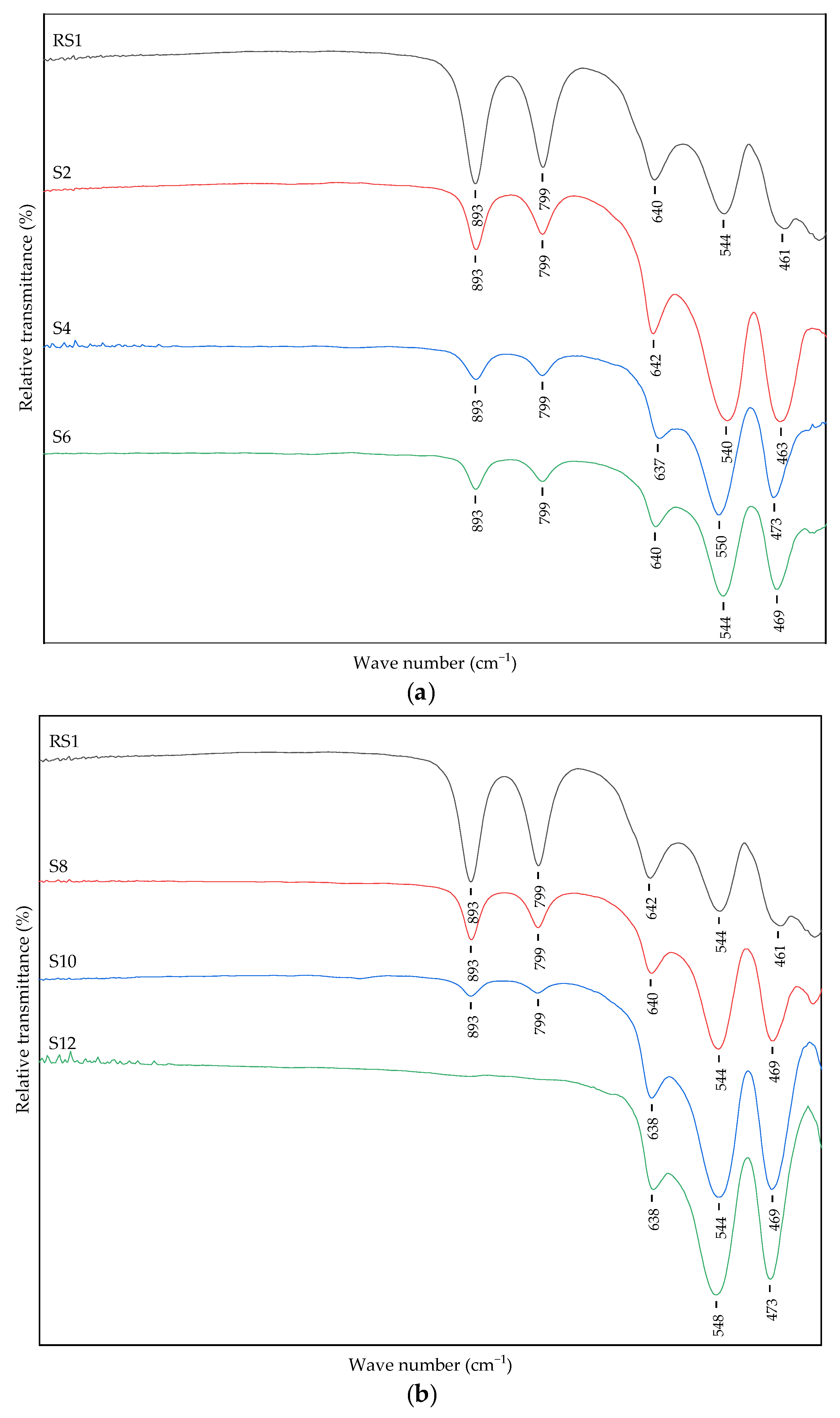

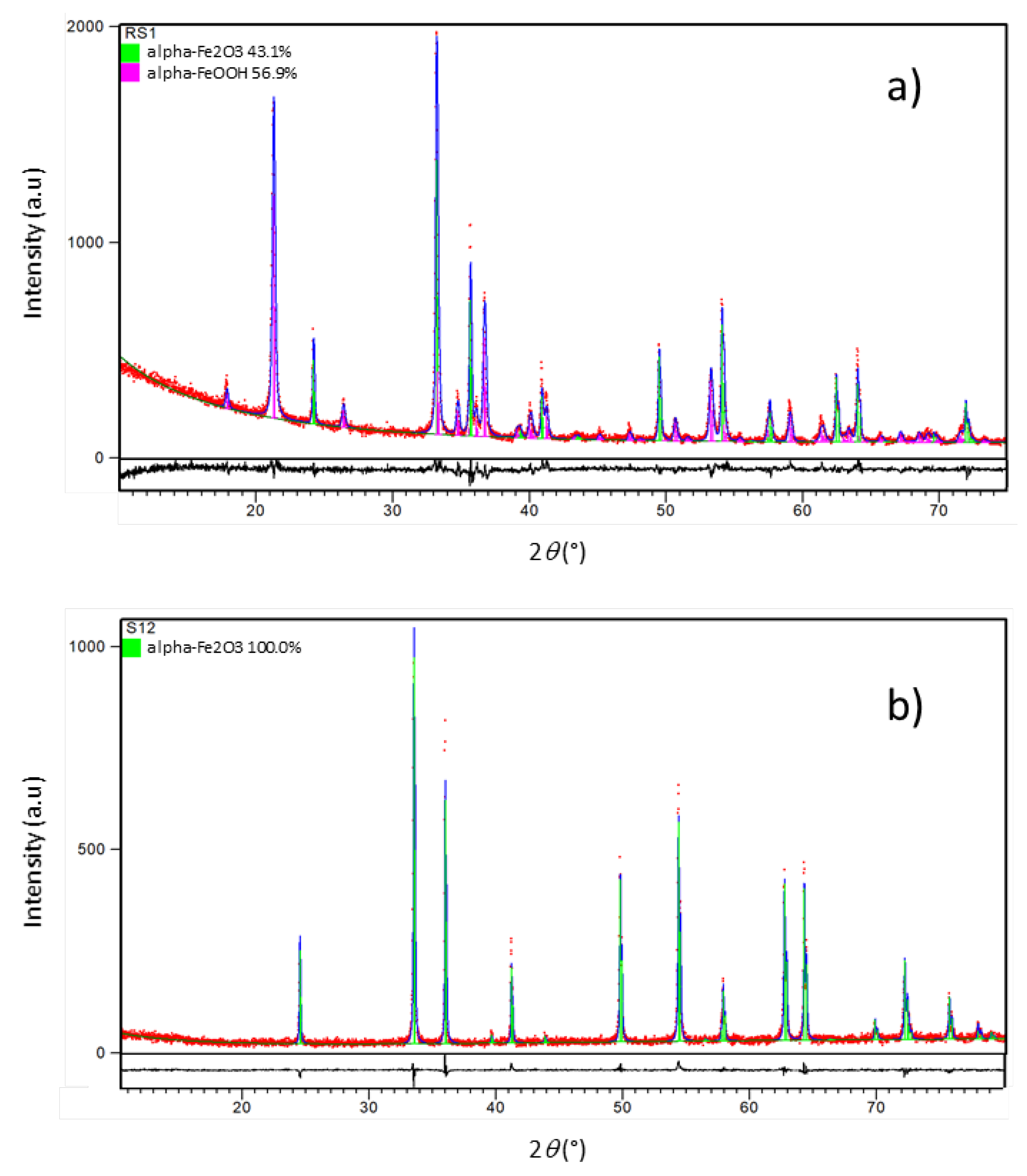
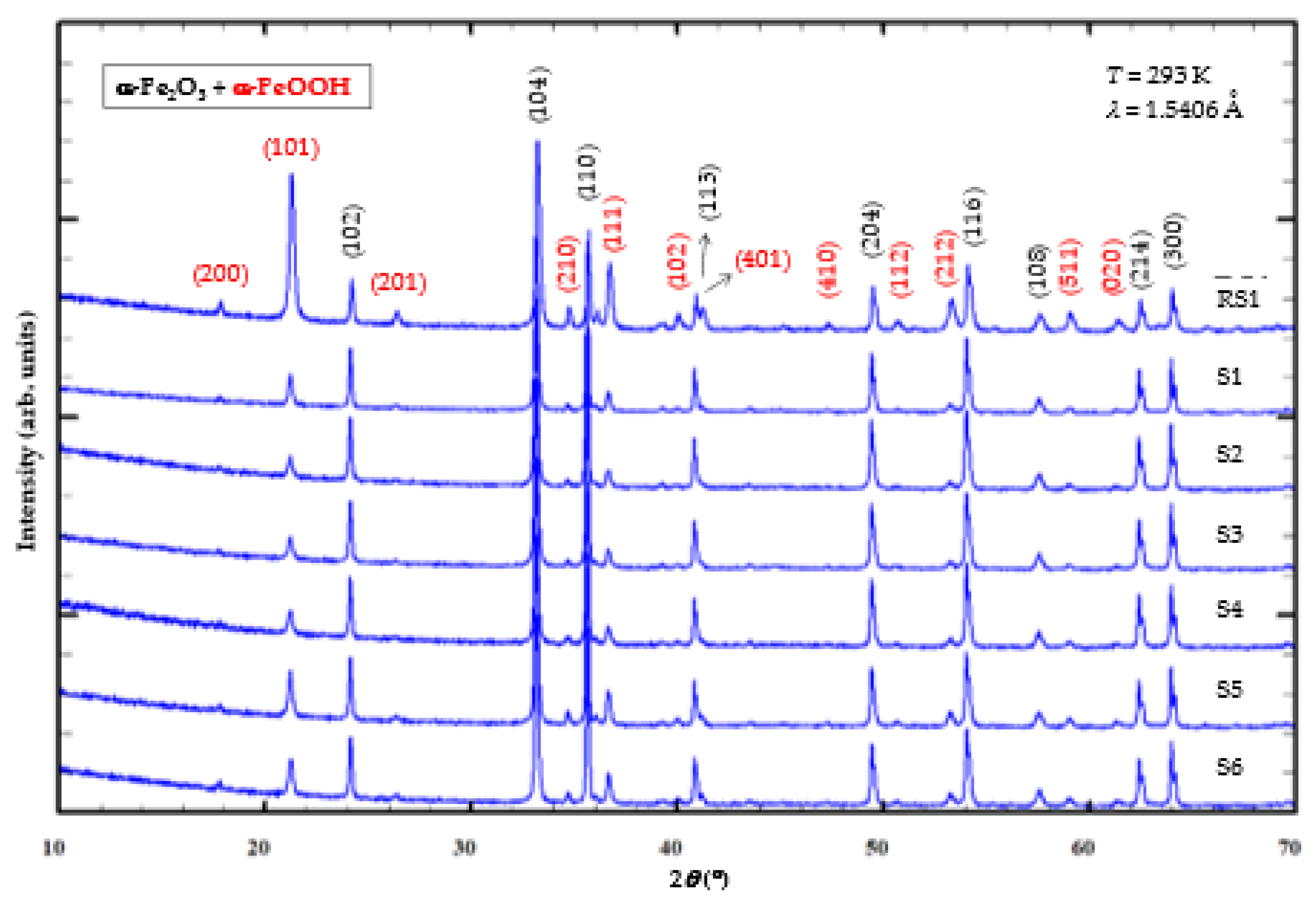
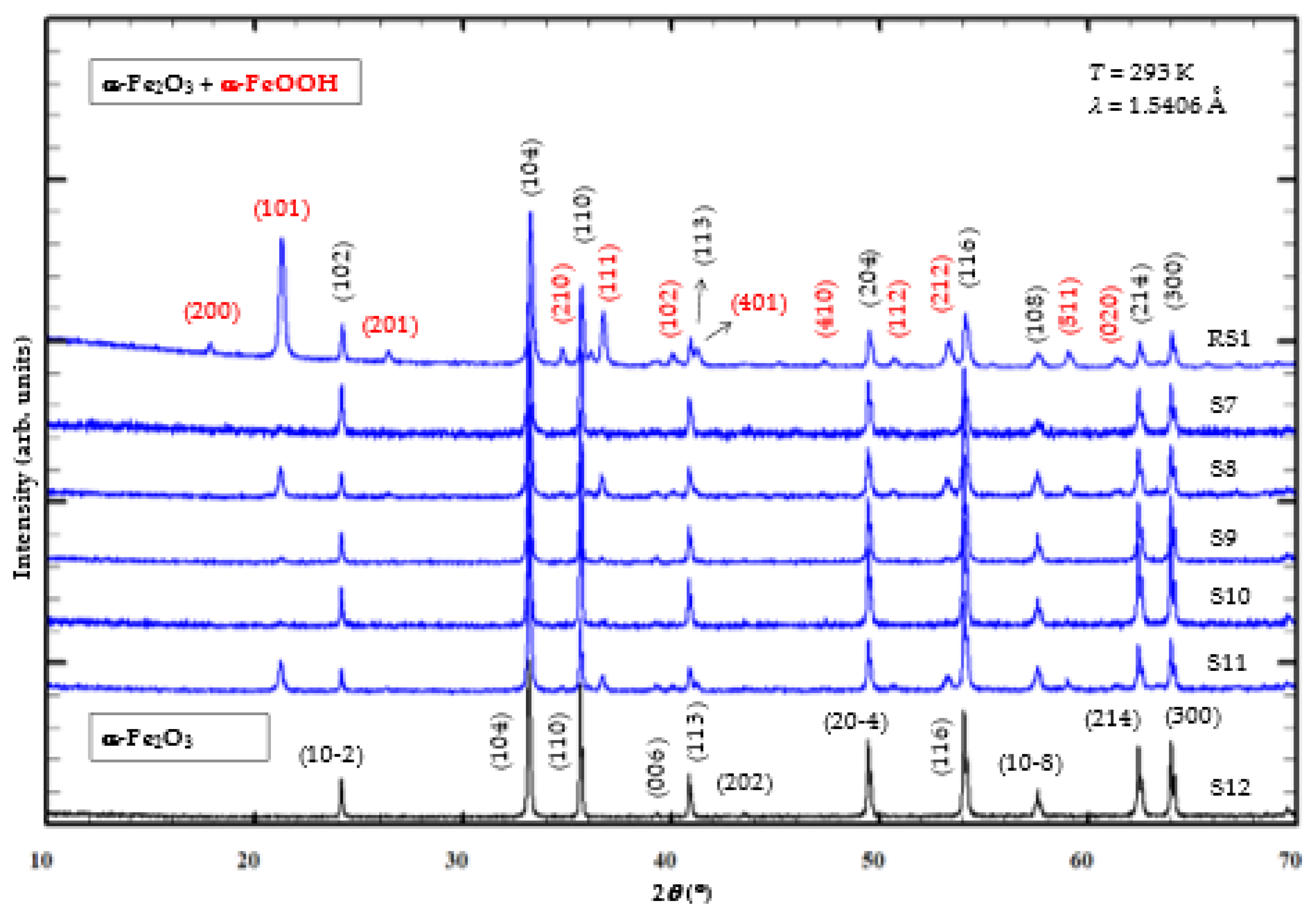
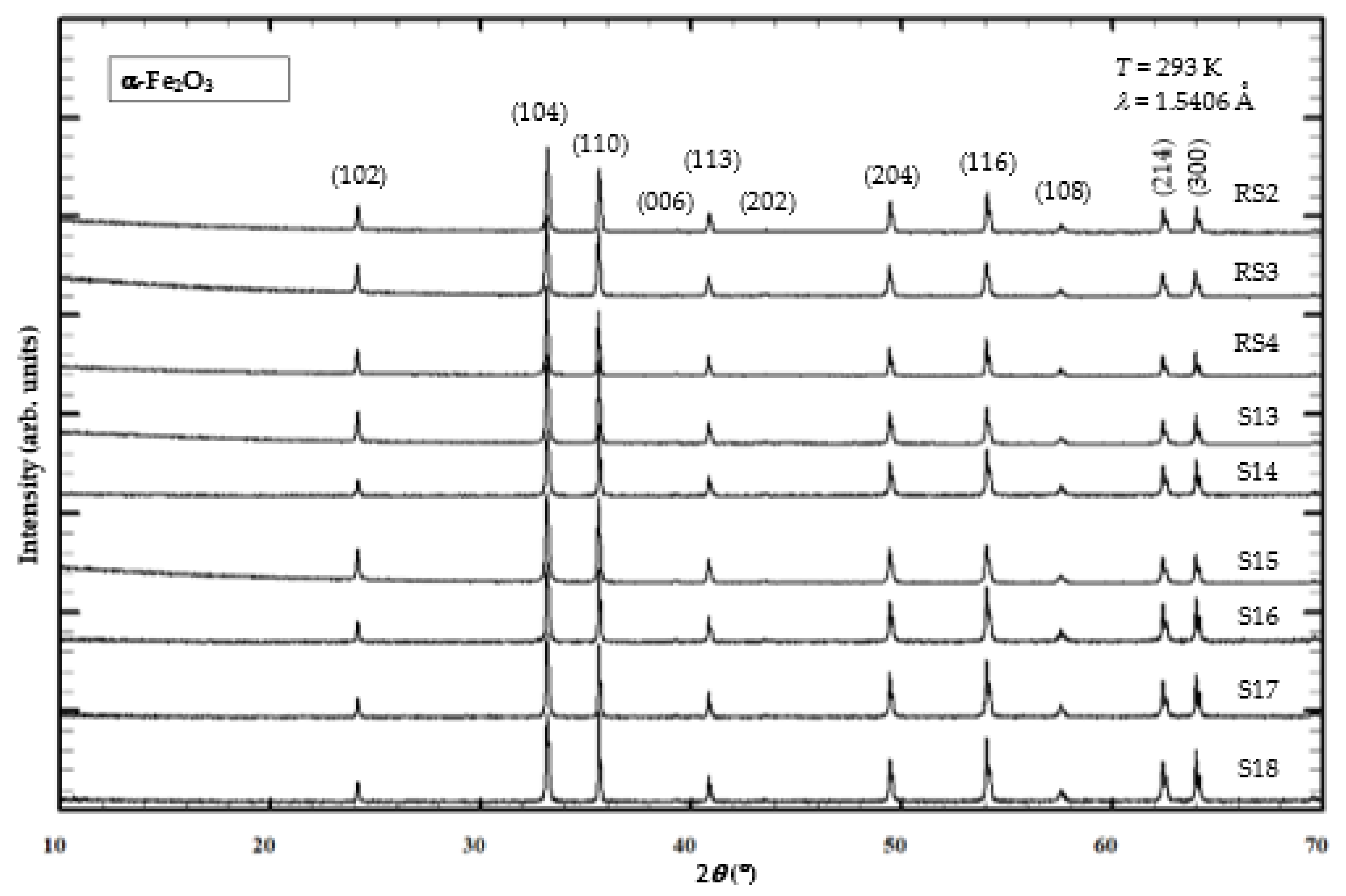



| Sample | Surfactant | Mass.% | pH | Sample | Essential Oil | Vol.% | pH |
|---|---|---|---|---|---|---|---|
| RS1 | - | - | 13.28 | S7 | sage | 1.0 | 13.22 |
| S1 | PEG 1 | 1.0 | 13.04 | S8 | sage | 4.5 | 13.06 |
| S2 | PEG 1 | 4.5 | 13.15 | S9 | rosemary | 1.0 | 13.09 |
| S3 | NGS 2 | 1.0 | 12.81 | S10 | rosemary | 4.5 | 13.14 |
| S4 | NGS 2 | 4.5 | 9.50 | S11 | lavender | 1.0 | 13.26 |
| S5 | SDS 3 | 1.0 | 13.07 | S12 | lavender | 4.5 | 13.23 |
| S6 | SDS 3 | 4.5 | 13.03 |
| Sample | Surfactant | Mass.% | t/min | pH | Sample | Essential Oil | Vol.% | t/min | pH |
|---|---|---|---|---|---|---|---|---|---|
| RS2 | - | - | 20 | 13.24 | S16 | sage | 1 | 5 | 13.12 |
| RS3 | - | - | 10 | 13.09 | S17 | rosemary | 1 | 5 | 12.24 |
| RS4 | - | - | 5 | 13.14 | S18 | lavender | 1 | 5 | 13.14 |
| S13 | PEG 1 | 1 | 5 | 13.04 | |||||
| S14 | NGS 2 | 1 | 5 | 12.93 | |||||
| S15 | SDS 3 | 1 | 5 | 13.04 |
| Sample | Unit Cell Metrics/Å | Crystallite Size/nm | Phase Fraction/wt.% | Rwp /% | |||
|---|---|---|---|---|---|---|---|
| α-Fe2O3 (s.g. R-3c) | α-FeOOH (s.g. Pbnm) | α-Fe2O3 | α-FeOOH | α-Fe2O3 | α-FeOOH | ||
| RS1 | a = 5.0359(2) c = 13.7571(4) | a = 9.9570(7) b = 3.0216(2) c = 4.6085(3) | 103.1(1) | 73.1(1) | 43.1 | 56.9 | 2.43 |
| S1 | a = 5.0359(9) c = 13.7568(2) | a = 9.957(1) b = 3.0220(2) c = 4.6087(4) | 146.2(1) | 46.2(1) | 80.3 | 19.7 | 2.07 |
| S2 | a = 5.0364(1) c = 13.7586(3) | a = 9.957(1) b = 3.0226(3) c = 4.6093(6) | 125.0(1) | 39.7(1) | 84.7 | 15.2 | 1.30 |
| S3 | a = 5.0358(1) c = 13.7577(3) | a = 9.955(1) b = 3.0225(3) c = 4.6079(5) | 142.5(1) | 42.6(1) | 84.0 | 16.0 | 2.59 |
| S4 | a = 5.0358(1) c = 13.7579(4) | a = 9.959(2) b = 3.0220(4) c = 4.6091(7) | 157.2(2) | 39.6(1) | 82.1 | 17.9 | 2.38 |
| S5 | a = 5.03609(1) c = 13.7582(3) | a = 9.9561(8) b = 3.0222(2) c = 4.6082(4) | 177.5(1) | 46.0(1) | 71.4 | 28.6 | 1.47 |
| S6 | a = 5.0357(1) c = 13.7563(3) | a = 9.958(1) b = 3.0218(3) c = 4.6087(4) | 166.6(1) | 45.9(1) | 75.5 | 24.5 | 2.02 |
| S7 | a = 5.0348(1) c = 13.7500(4) | a = 9.953(8) b = 3.023(2) c = 4.596(4) | 172.1(1) | 53.2(1) | 98.0 | 2.0 | 1.59 |
| S8 | a = 5.0348(6) c = 13.752(3) | a = 9.957(5) b = 3.0214(4) c = 4.6059(5) | 130.2(1) | 51.6(1) | 74.9 | 25.1 | 2.23 |
| S9 | a = 5.03451(8) c = 13.7501(3) | a = 9.949(4) b = 3.021(1) c = 4.605(2) | 173.1(2) | 44.6(2) | 96.4 | 3.6 | 1.58 |
| S10 | a = 5.0346(1) c = 13.7500(4) | a = 9.960(5) b = 3.0195(8) c = 4.607(2) | 182.3(2) | 98.1(2) | 96.8 | 3.2 | 1.98 |
| S11 | a = 5.0348(3) c = 13.7513(3) | a = 9.957(4) b = 3.021(1) c = 4.6068(7) | 170.2(1) | 50.4(1) | 74.2 | 25.8 | 2.01 |
| S12 | a = 5.03600(7) b = 13.7546(2) | 220.4(1) | - | 100 | - | 1.95 | |
| Sample | Unit Cell Metrics α-Fe2O3 (s.g. R-3c) | Crystallite Size/nm | Phase Fraction/wt.% | Rwp /% | |
|---|---|---|---|---|---|
| a/Å | c/Å | α-Fe2O3 | α-Fe2O3 | ||
| RS2 | 5.0345(1) | 13.7511(2) | 194.2(2) | 100 | 8.50 |
| RS3 | 5.0370(2) | 13.7576(4) | 102.7(3) | 100 | 8.64 |
| RS4 | 5.0351(1) | 13.7520(3) | 98.7(2) | 100 | 8.40 |
| S13 | 5.0358(1) | 13.7544(3) | 140.3(1) | 100 | 8.66 |
| S14 | 5.0349(1) | 13.7513(3) | 190.3(2) | 100 | 2.08 |
| S15 | 5.0361(1) | 13.7570(3) | 150.2(1) | 100 | 8.66 |
| S16 | 5.0350(1) | 13.7503(3) | 190.3(2) | 100 | 1.99 |
| S17 | 5.0350(2) | 13.7512(3) | 203.9(1) | 100 | 1.93 |
| S18 | 5.035(1) | 13.751(2) | 221.7(1) | 100 | 2.15 |
Publisher’s Note: MDPI stays neutral with regard to jurisdictional claims in published maps and institutional affiliations. |
© 2022 by the authors. Licensee MDPI, Basel, Switzerland. This article is an open access article distributed under the terms and conditions of the Creative Commons Attribution (CC BY) license (https://creativecommons.org/licenses/by/4.0/).
Share and Cite
Mitar, I.; Guć, L.; Vrankić, M.; Paut, A.; Marciuš, M.; Prkić, A.; Krehula, S.; Mastelić, A.; Ramljak, J.; Ćurlin, P. The Effects of Surfactants and Essential Oils on Microwave−Assisted Hydrothermal Synthesis of Iron Oxides. Crystals 2022, 12, 1567. https://doi.org/10.3390/cryst12111567
Mitar I, Guć L, Vrankić M, Paut A, Marciuš M, Prkić A, Krehula S, Mastelić A, Ramljak J, Ćurlin P. The Effects of Surfactants and Essential Oils on Microwave−Assisted Hydrothermal Synthesis of Iron Oxides. Crystals. 2022; 12(11):1567. https://doi.org/10.3390/cryst12111567
Chicago/Turabian StyleMitar, Ivana, Lucija Guć, Martina Vrankić, Andrea Paut, Marijan Marciuš, Ante Prkić, Stjepko Krehula, Anđela Mastelić, Josipa Ramljak, and Paula Ćurlin. 2022. "The Effects of Surfactants and Essential Oils on Microwave−Assisted Hydrothermal Synthesis of Iron Oxides" Crystals 12, no. 11: 1567. https://doi.org/10.3390/cryst12111567
APA StyleMitar, I., Guć, L., Vrankić, M., Paut, A., Marciuš, M., Prkić, A., Krehula, S., Mastelić, A., Ramljak, J., & Ćurlin, P. (2022). The Effects of Surfactants and Essential Oils on Microwave−Assisted Hydrothermal Synthesis of Iron Oxides. Crystals, 12(11), 1567. https://doi.org/10.3390/cryst12111567








